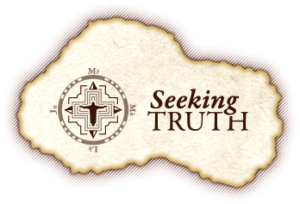Podcast: Play in new window | Download (Duration: 30:40 — 21.2MB) | Embed
Subscribe: Apple Podcasts | Spotify | Amazon Music | Android | Pandora | iHeartRadio | JioSaavn | Podchaser | Gaana | Podcast Index | Email | TuneIn | Deezer | Anghami | RSS | More
Episode 10 – The Gospel of Luke – Chapter 4 Part 2
Temptations & Ministry
This lecture begins by recalling the baptism of Jesus by John. John, the New Elijah, was well aware of his role. He always pointed towards Jesus. The baptism was a theophany, with all members of the Trinity present: the voice of the Father from above, the Holy Spirit in the bodily form of a dove, and Jesus himself. Not since the Garden of Eden has the Trinity so clearly been seen, and the baptism gives us hope for what we lost with Adam and Eve’s fall from grace. According to Cyril of Jerusalem, “Jesus’ descent into this water tomb, into this inferno that envelops him on every side, is thus an anticipation of his act into descending into the underworld.” The baptism of Jesus takes place at Bethabara beyond the Jordan, which is just north of the Dead Sea, the lowest spot on the face of the earth (418 feet below sea level).
Several other pivotal events in salvation history have occurred in this location. Joshua and the Israelite nation crossed into the Promised Land, carrying the Ark of the Covenant (Joshua 4). Also, the story of Elijah and Elisha takes place in this region (1 Kings and 2 Kings). Elijah encounters Elisha, who is plowing the field with 12 yoke of oxen, which suggests Elisha was blessed with supernatural strength to control such a large number of oxen. The number 12 is also symbolic for governance and the 12 tribes of Israel. Elijah casts his mantle on Elisha, who then slaughters the oxen and abandons his life as a farmer, and accompanies Elijah. Elijah then later parts the waters of the Jordan by striking the water with his mantle, which recalls the crossing of Joshua and the Israelites. When Elijah is taken up in the fiery chariot, he throws his mantle down to Elisha, who requests and is gifted with a double portion of the spirit of Elijah. Shortly afterward, Elisha also parts the Jordan River by striking the water with Elijah’s mantle. The parting of the water prefigures the Baptism of Jesus: both events are symbolic of passage from certain death to a new life. As John the Baptist is the new Elijah, so then is Jesus the new Elisha: Elisha inherits a double portion of the spirit, while Jesus is one with the Spirit. Jesus is the new Adam, the new Moses, the new Joshua, the new Elisha.
We then turn our attention to the temptation of Jesus in the desert. After 40 days and nights of fasting, Satan appears to Jesus, who may have been at his weakest physically, but was at his strongest spiritually. Satan begins his temptations with, “IF you are the Son of God…” Does Satan know if Jesus is the Messiah? Jesus’ identity as the Messiah was not clearly seen by Satan. This so-called Messianic Secret is seen in other places in Scripture where Jesus commands his followers to maintain silence about his Messianic mission (see Mark 1:43 and 8:29-30). Why did Jesus desire to keep his Messianic identity a secret? According to Ignatius of Antioch, there were three mysteries in God’s plan of salvation that had to be kept secret: the virginity of Mary, the virgin birth of Jesus, and Jesus’ death on the cross. In each of these three instances, the identity of Jesus as Messiah is hidden from the world so that the Father’s plan of salvation would not be thwarted.
Continuing on, we learn about the rejection of Jesus at Nazareth. Initially, those who hear Jesus in the synagogue respond favorably to Jesus’ words, especially when He proclaims that he fulfills the prophecy of Isaiah 61: “The Spirit of the Lord is upon me because he has anointed me to bring good news to the poor. He has sent me to proclaim release to the captives and recovery of sight to the blind, to let the oppressed go free, to proclaim the year of the Lord’s favor.” However, the crowd turns against Jesus and attempts to throw Him over the side of a cliff. Why such a change in heart? Because Jesus references two Old Testament stories which reveal God’s favor for the Gentiles. “But the truth is, there were many widows in Israel in the time of Elijah when the heaven was shut up three years and six months, and there was a severe famine over all the land; yet Elijah was sent to none of them except to a widow at Zarephath in Sidon. There were also many lepers in Israel in the time of the prophet Elisha, and none of them was cleansed except Naaman the Syrian (Luke 4:24-26).”
©2019 Seeking Truth Catholic Bible Study
Sharon Doran serves as the teaching director of “Seeking Truth.” An experienced Bible Study teacher, Sharon has a passion for scripture that will motivate and challenge you to immerse yourself in God’s Word and apply His message to your everyday life.
For more in this series, visit the Seeking Truth with Sharon Doran Discerning Hearts page.
 “Seeking Truth” is an in-depth Catholic Bible Study commissioned by the Archdiocese of Omaha in response to John Paul II’s call to the New Evangelization as well as Pope Benedict XVI’s exhortation for all Catholics to study scripture. To learn more, go to www.seekingtruth.net
“Seeking Truth” is an in-depth Catholic Bible Study commissioned by the Archdiocese of Omaha in response to John Paul II’s call to the New Evangelization as well as Pope Benedict XVI’s exhortation for all Catholics to study scripture. To learn more, go to www.seekingtruth.net


